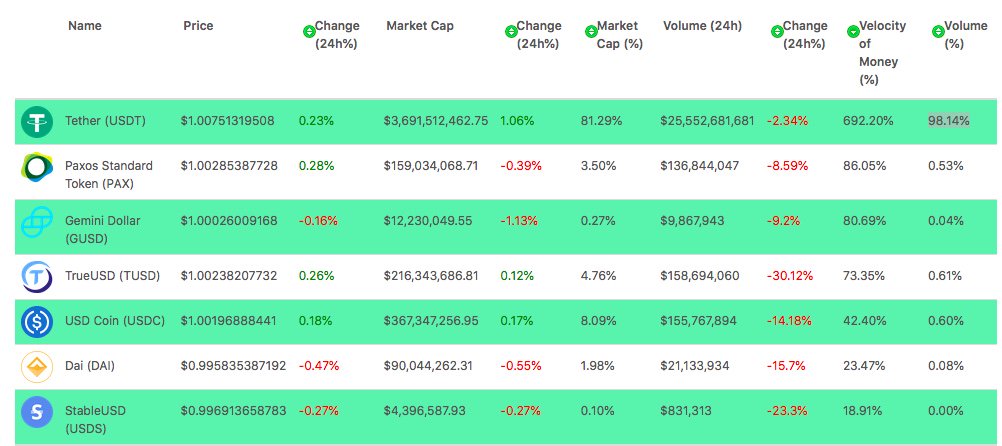Love, hate or fear it, there’s no avoiding tether (USDT).
Its shadow looms over the cryptoconomy, supplying sanctuary in times of
volatility, providing fiat capital inflow and acting as a lightning rod
for crypto critics who believe it’s propping up the price of bitcoin.
Over the past year, a flurry of new stablecoins have entered the market,
each vying to topple tether and provide a more transparent and fully
audited alternative. So far, they have scarcely made a dent in tether’s
dominance.
Despite a String of Contenders, Stablecoins Can’t Topple Tether
Stablecoins have attracted less
attention this year because revitalized crypto markets have given
traders less cause to rely on them. Last year, everyone was issuing new
stablecoins, but that trend has slowed to a trickle. On July 3, a new
stablecoin did enter the fray, although this one has no designs on
displacing tether. Pink Care Token (PCAT) is a stablecoin issued as part of a Binance-fronted initiative to supply feminine hygiene products to Ugandan women.
From an altruistic perspective, the
project, which has the support of 46 crypto companies, seems
well-intentioned and is indicative of how far stablecoins,
and the cryptocurrency industry in general, have come. The same
properties that enable donors to track the funds contributed to
Binance’s charitable initiative are used to monitor the movements of
stablecoins throughout the crypto ecosystem and they paint a picture of a
market that’s heavily skewed in tether’s favor.

Even when the cryptosphere is
comparatively calm, stablecoins capture a huge chunk of trading volume.
Or rather tether does. The rest barely register. Despite being the
eighth largest crypto asset by market cap, tether accounts for the
second highest trading volume after BTC, with $35B swapped per day on average. The next closest competitor, USDC, captures just one tenth of USDT’s volume.
The Rise and Fall of the Gemini Dollar
One of the most curious casualties in
the stablecoin wars has been the Gemini dollar (GUSD). At its peak, the
fiat-backed stablecoin’s market cap stood at $103M, but today that has
dropped to just $12.5M. Other leading stablecoins have followed a
similar trend, with the total number of circulating tokens for paxos,
stably and USDC all diminishing this year. The only leading stablecoin
to have increased its market cap is tether, which now stands at close to
$4B.

Twitter account @usdcoinprinter
tracks the issuance of stablecoins, but so far there’s only one token
being minted, and what’s more it’s being minted en masse. To place this
in context, tether frequently issues 10X the entire market
capitalization of its closest competitor in one swoop. USDT is to stablecoins what BTC
is to altcoins, but whereas bitcoin’s dominance stands at 62%, tether
is capturing 98% of all stablecoin volume. Traders have perfectly viable
USDT
alternatives, but so far they have yet to see the wisdom or the need to
switch. With the vast majority of all stablecoins never leaving the
exchanges they’re traded on, it makes little difference to investors
what denominated dollar-pegged token they’re using. Tether works – for
now, anyway.
The Interminable Tether Debate
Whether you believe tether is
propping up bitcoin’s latest rally depends on who you speak to. Some
commenters, such as David Gerard, who believes the entire cryptosphere
is a giant scam yet can’t resist reporting on anything else, see
manipulation. Other discredited critics such as Nouriel Roubini agree.
On the other side of the divide, there are more sanguine voices, such as
Kraken’s Jesse Powell, who does not ascribe to this theory.
“I don’t have inside knowledge of
what’s happening at Tether, but I can tell you that, historically, when
you’ve seen growth in the supply of Tether, we’ve seen growth in the
supply of U.S. dollars coming onto Kraken. And other exchanges would
report the same,” he noted.
In other words, correlation does not
equal causation. “There are days when you see the price going up ten
percent a day. You can bet all the exchanges are onboarding fifty to a
hundred thousand new users a day. That is what is driving up the price.
It’s huge retail demand and all the media attention on it. It’s not
Tether,” insisted the Kraken CEO.

Crypto Assets Backed by Belief
A series of global socio-economic
events can be attributed to heightening interest in bitcoin, including
escalating trade wars and economic sanctions. Demand for bitcoin in Iran
has increased as the U.S. has sought to cut off capital inflows through
tightening sanctions. Meanwhile, capital controls in China make it hard
for the wealthy to get their money out of the country, with bitcoin one
of the few ways in which this can be effectively done. Meanwhile, in
the U.S. there’s been a kickback against the super rich, with populist
politicians on the left advocating high taxes on the wealthy. Bitcoin is
a haven for people who believe they risk having their net worth
drastically slashed by punitive taxation.

One thing everyone seems to agree on
is that bitcoin’s latest price rally hasn’t been retail driven: Google
Trends data shows that interest in buying bitcoin remains low, adding
weight to the notion that larger forces are at play, and that global
macro trends are driving the action rather than retail FOMO. In other
words, tether may have very little to do with it.
Regardless of what’s propping up the
cryptoconomy at present, all assets, from bitcoin to the U.S. dollar,
are backed by collective belief. For so long as people believe 1 USDT
is worth 1 USD, and that 1 USD has an agreed measure of purchasing
power, tether will maintain its peg and its near total dominance of the
stablecoin market.
source link











